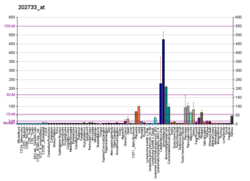P4HA2
Prolyl 4-hydroxylase subunit alpha-2 is an enzyme that in humans is encoded by the P4HA2 gene.[5][6][7]
This gene encodes a component of prolyl 4-hydroxylase, a key enzyme in collagen synthesis composed of two identical alpha subunits and two beta subunits. The encoded protein is one of several different types of alpha subunits and provides the major part of the catalytic site of the active enzyme. In collagen and related proteins, prolyl 4-hydroxylase catalyzes the formation of 4-hydroxyproline that is essential to the proper three-dimensional folding of newly synthesized procollagen chains. Alternatively spliced transcript variants encoding different isoforms have been described.[7]
References
Notes
- 1 2 3 GRCh38: Ensembl release 89: ENSG00000072682 - Ensembl, May 2017
- 1 2 3 GRCm38: Ensembl release 89: ENSMUSG00000018906 - Ensembl, May 2017
- ↑ "Human PubMed Reference:".
- ↑ "Mouse PubMed Reference:".
- ↑ Annunen P, Helaakoski T, Myllyharju J, Veijola J, Pihlajaniemi T, Kivirikko KI (Aug 1997). "Cloning of the human prolyl 4-hydroxylase alpha subunit isoform alpha(II) and characterization of the type II enzyme tetramer. The alpha(I) and alpha(II) subunits do not form a mixed alpha(I)alpha(II)beta2 tetramer". J Biol Chem. 272 (28): 17342–8. doi:10.1074/jbc.272.28.17342. PMID 9211872.
- ↑ Frazer KA, Ueda Y, Zhu Y, Gifford VR, Garofalo MR, Mohandas N, Martin CH, Palazzolo MJ, Cheng JF, Rubin EM (Aug 1997). "Computational and biological analysis of 680 kb of DNA sequence from the human 5q31 cytokine gene cluster region". Genome Res. 7 (5): 495–512. doi:10.1101/gr.7.5.495. PMID 9149945.
- 1 2 "Entrez Gene: P4HA2 procollagen-proline, 2-oxoglutarate 4-dioxygenase (proline 4-hydroxylase), alpha polypeptide II".
Further reading
- Helaakoski T, Annunen P, Vuori K, et al. (1995). "Cloning, baculovirus expression, and characterization of a second mouse prolyl 4-hydroxylase alpha-subunit isoform: formation of an alpha 2 beta 2 tetramer with the protein disulfide-isomerase/beta subunit". Proc. Natl. Acad. Sci. U.S.A. 92 (10): 4427–31. doi:10.1073/pnas.92.10.4427. PMC 41957. PMID 7753822.
- Nokelainen M, Nissi R, Kukkola L, et al. (2001). "Characterization of the human and mouse genes for the alpha subunit of type II prolyl 4-hydroxylase. Identification of a previously unknown alternatively spliced exon and its expression in various tissues". Eur. J. Biochem. 268 (20): 5300–9. doi:10.1046/j.0014-2956.2001.02464.x. PMID 11606192.
- Strausberg RL, Feingold EA, Grouse LH, et al. (2003). "Generation and initial analysis of more than 15,000 full-length human and mouse cDNA sequences". Proc. Natl. Acad. Sci. U.S.A. 99 (26): 16899–903. doi:10.1073/pnas.242603899. PMC 139241. PMID 12477932.
- Hieta R, Kukkola L, Permi P, et al. (2003). "The peptide-substrate-binding domain of human collagen prolyl 4-hydroxylases. Backbone assignments, secondary structure, and binding of proline-rich peptides". J. Biol. Chem. 278 (37): 34966–74. doi:10.1074/jbc.M303624200. PMID 12824157.
- Kukkola L, Hieta R, Kivirikko KI, Myllyharju J (2004). "Identification and characterization of a third human, rat, and mouse collagen prolyl 4-hydroxylase isoenzyme". J. Biol. Chem. 278 (48): 47685–93. doi:10.1074/jbc.M306806200. PMID 14500733.
- Lehner B, Semple JI, Brown SE, et al. (2004). "Analysis of a high-throughput yeast two-hybrid system and its use to predict the function of intracellular proteins encoded within the human MHC class III region". Genomics. 83 (1): 153–67. doi:10.1016/S0888-7543(03)00235-0. PMID 14667819.
- Gerhard DS, Wagner L, Feingold EA, et al. (2004). "The Status, Quality, and Expansion of the NIH Full-Length cDNA Project: The Mammalian Gene Collection (MGC)". Genome Res. 14 (10B): 2121–7. doi:10.1101/gr.2596504. PMC 528928. PMID 15489334.
- Kimura K, Wakamatsu A, Suzuki Y, et al. (2006). "Diversification of transcriptional modulation: Large-scale identification and characterization of putative alternative promoters of human genes". Genome Res. 16 (1): 55–65. doi:10.1101/gr.4039406. PMC 1356129. PMID 16344560.
- Grimmer C, Balbus N, Lang U, et al. (2006). "Regulation of Type II Collagen Synthesis during Osteoarthritis by Prolyl-4-Hydroxylases : Possible Influence of Low Oxygen Levels". Am. J. Pathol. 169 (2): 491–502. doi:10.2353/ajpath.2006.050738. PMC 1698781. PMID 16877351.
- Koivunen P, Hirsilä M, Kivirikko KI, Myllyharju J (2006). "The length of peptide substrates has a marked effect on hydroxylation by the hypoxia-inducible factor prolyl 4-hydroxylases". J. Biol. Chem. 281 (39): 28712–20. doi:10.1074/jbc.M604628200. PMID 16885164.
- Teodoro JG, Parker AE, Zhu X, Green MR (2006). "p53-mediated inhibition of angiogenesis through up-regulation of a collagen prolyl hydroxylase". Science. 313 (5789): 968–71. doi:10.1126/science.1126391. PMID 16917063.
This article is issued from
Wikipedia.
The text is licensed under Creative Commons - Attribution - Sharealike.
Additional terms may apply for the media files.




